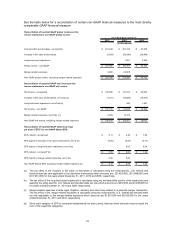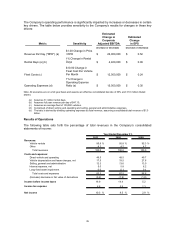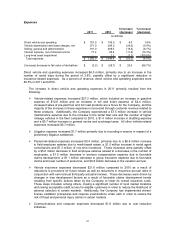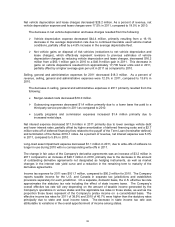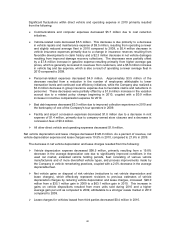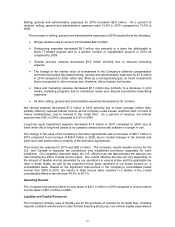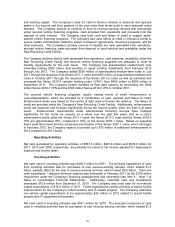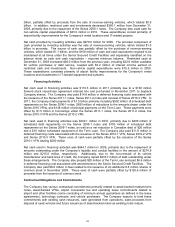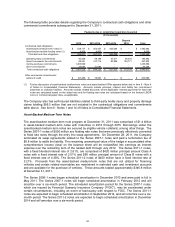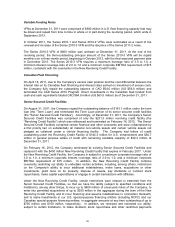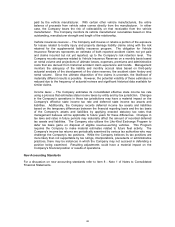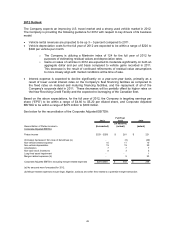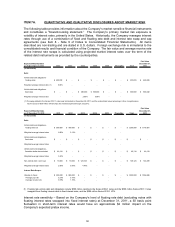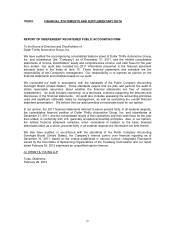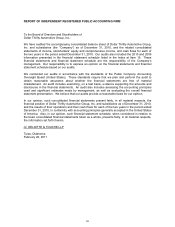Thrifty Car Rental 2011 Annual Report Download - page 44
Download and view the complete annual report
Please find page 44 of the 2011 Thrifty Car Rental annual report below. You can navigate through the pages in the report by either clicking on the pages listed below, or by using the keyword search tool below to find specific information within the annual report.and working capital. The Company’s need for cash to finance vehicles is seasonal and typically
peaks in the second and third quarters of the year when fleet levels build to meet seasonal rental
demand. The Company expects to continue to fund its revenue-earning vehicles with borrowings
under secured vehicle financing programs, cash provided from operations and proceeds from the
disposal of used vehicles. The Company uses both cash and letters of credit to support asset-
backed vehicle financing programs. The Company also uses letters of credit or insurance bonds to
secure certain commitments related to airport concession agreements, insurance programs, and for
other purposes. The Company’s primary sources of liquidity are cash generated from operations,
secured vehicle financing, sales proceeds from disposal of used vehicles and availability under the
New Revolving Credit Facility.
The Company believes that its cash generated from operations, cash balances, availability under the
New Revolving Credit Facility and secured vehicle financing programs are adequate to meet its
liquidity requirements for the near future. The Company has asset-backed medium-term note
maturities totaling $500 million that amortize in equal monthly installments from February 2012
through July 2012. The Company added $500 million of asset-backed medium-term notes in July
2011 through the issuance of its Series 2011-1 notes and $400 million of asset-backed medium-term
notes in October 2011 through the issuance of the Series 2011-2 notes as well as extended and
increased the Series 2010-3 variable funding notes (“VFN”) from $450 million to $600 million in
September 2011. The Company further modified its fleet debt capacity by terminating the $200
million Series 2010-1 VFN and the $300 million Series 2010-2 VFN in October 2011.
The secured vehicle financing programs require varying levels of credit enhancement or
overcollateralization, which are provided by a combination of cash, vehicles and letters of credit.
Enhancement levels vary based on the source of debt used to finance the vehicles. The letters of
credit are provided under the Company’s New Revolving Credit Facility. Additionally, enhancement
levels are seasonal and increase significantly during the second quarter when the fleet is at peak
levels. Enhancement requirements under asset-backed financing sources have changed
significantly for the rental car industry as a whole over the past few years, and as a result,
enhancement levels under the Series 2011-1 notes, the Series 2011-2 notes and the Series 2010-3
VFN are approximately 45%, compared to 30% on the Series 2007-1 notes. Based on expected
future peak fleet levels and the scheduled amortization of the Series 2007-1 notes, which will begin
in February 2012, the Company expects to provide up to $75 million of additional enhancement in
2012 compared to 2011 levels.
Operating Activities
Net cash generated by operating activities of $567.3 million, $461.9 million and $535.9 million for
2011, 2010 and 2009, respectively, are primarily the result of net income adjusted for depreciation
expense and income taxes.
Investing Activities
Net cash used in investing activities was $402.5 million for 2011. The principal expenditure of cash
from investing activities was for purchases of new revenue-earning vehicles, which totaled $1.2
billion, partially offset by the sale of revenue-earning vehicles, which totaled $0.8 billion. Cash and
cash equivalents – required minimum balance was eliminated in February 2011 as the $100 million
requirement under the Company’s financing arrangements was eliminated (see Item 8 – Note 1 of
Notes to Consolidated Financial Statements). Additionally, restricted cash and investments
decreased $75.9 million from December 31, 2010. The Company also used cash for non-vehicle
capital expenditures of $16.6 million in 2011. These expenditures consist primarily of airport facility
improvements for the Company’s rental locations and IT-related projects. The Company estimates
non-vehicle capital expenditures to be approximately $25 million in 2012 related to airport facility
projects and IT equipment and systems.
Net cash used in investing activities was $59.1 million for 2010. The principal component of cash
used in investing activities was for purchases of new revenue-earning vehicles, which totaled $1.2
42



